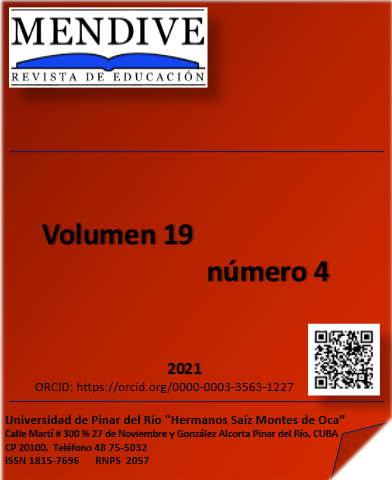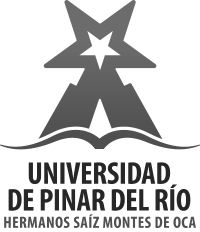Algunos mitos más difundidos sobre las TIC en la educación. ¿Cómo evitarlos?
Contenido principal del artículo
Resumen
Descargas
Detalles del artículo
Citas
Aarts, J. (2010). Use of "serious health games" in health care: a review. Information Technology in Health Care: Socio-Technical Approaches, 160.
AlDahdouh, A. A., Osório, A. J., & Caires, S. (2015). Understanding knowledge network, learning and connectivism. International Journal of Instructional Technology and Distance Learning, 12(10). https://files.eric.ed.gov/fulltext/ED572896.pdf
Avello, R., & Requeiro, R. (2018). A propósito del artículo "Experiencia en la adaptación de actividades a los estilos de aprendizaje desde la educación de posgrado a distancia". Educación Médica Superior, 32(1), Article 1. http://www.ems.sld.cu/index.php/ems/article/view/1281
Avello, R., Rodríguez, M. A., Rodríguez, P., Sosa, D., Companioni, B., & Rodríguez, R. L. (2019). ¿Por qué enunciar las limitaciones del estudio? MediSur, 17(1), 10-12.
Bullen, M., Morgan, T., Belfer, K., & Qayyum, A. (2008). The digital learner at BCIT and implications for an e-strategy. https://app.box.com/s/fxqyutottt
Clarà, M., & Barberà, E. (2014). Three problems with the connectivist conception of learning. Journal of Computer Assisted Learning, 30(3), 197-206. https://doi.org/10.1111/jcal.12040
Coffield, Ecclestone, K., Moseley, & Hall, E. (2004). Learning styles and pedagogy in post 16 education: A critical and systematic review. https://www.researchgate.net/publication/232929341
Creswell, J. W. (2014). A Concise Introduction to Mixed Methods Research. https://us.sagepub.com/en-us/nam/a-concise-introduction-to-mixed-methods-research/book243856
De Bruyckere, P., Kirschner, P. A., & Hulshof, C. D. (2015). Urban Myths About Learning and Education. London: Academic Press. https://www.sciencedirect.com/book/9780128015377/urban-myths-about-learning-and-education
De Bruyckere, P., Kirschner, P. A., & Hulshof, C. D. (2019). More Urban Myths About Learning and Education: Challenging Eduquacks, Extraordinary Claims, and Alternative Facts. Routledge. https://www.routledge.com/More-Urban-Myths-About-Learning-and-Education-Challenging -Eduquacks-Extraordinary/Bruyckere-Kirschner-Hulshof/p/book/9780815354581
de Freitas, S. (2018). Are Games Effective Learning Tools? A Review of Educational Games. Journal of Educational Technology & Society, 21(2), 74-84.
Gardner, H., & Davis, K. (2013). The App Generation: How Today's Youth Navigate Identity, Intimacy, and Imagination in a Digital World. Yale University Press. https://www.jstor.org/stable/j.ctt5vm7dh
George-Reyes, C.E., & Avello-Martínez, R. (2021). Competencias digitales para la práctica docente en pregrado en dos universidades latinoamericanas. EDMETIC, Revista de Educación Mediática y TIC, 10(1), 1-19. https://doi.org/10.21071/edmetic.v10i1.12713
Girard, C., Ecalle, J., & Magnan, A. (2013). Serious games as new educational tools: How effective are they? A meta-analysis of recent studies. Journal of Computer Assisted Learning, 29(3), 207-219. https://doi.org/10.1111/j.1365-2729.2012.00489.x
Gladstones, W. H., Regan, M. A., & Lee, R. B. (1989). Division of attention: The single-channel hypothesis revisited. The Quarterly Journal of Experimental Psychology Section A, 41(1), 1-17. https://doi.org/10.1080/14640748908402350
Jemielniak, D. (2019). Wikipedia: Why is the common knowledge resource still neglected by academics? GigaScience, 8(giz139). https://doi.org/10.1093/gigascience/giz139
Kennedy, D. M., & Fox, B. (2013). "Digital Natives": An Asian Perspective for Using Learning Technologies. International Journal of Education and Development Using Information and Communication Technology, 9(1), 64-79.
Kirschner, P. A. (2017). Stop propagating the learning styles myth. Computers & Education, 106, 166-171. https://doi.org/10.1016/j.compedu.2016.12.006
Kirschner, P. A., & van Merriënboer, J. J. G. (2013). Do Learners Really Know Best? Urban Legends in Education. Educational Psychologist, 48(3), 169-183. https://doi.org/10.1080/00461520.2013.804395
Kop, R., & Hill, A. (2008). Connectivism: Learning theory of the future or vestige of the past? The International Review of Research in Open and Distributed Learning, 9(3). https://doi.org/10.19173/irrodl.v9i3.523
London, D. A., Andelman, S. M., Christiano, A. V., Kim, J. H., Hausman, M. R., & Kim, J. M. (2019). Is Wikipedia a complete and accurate source for musculoskeletal anatomy? Surgical and Radiologic Anatomy, 41(10), 1187-1192. https://doi.org/10.1007/s00276-019-02280-1
López, I., Avello, R., Baute, L. M., & Vidal, M. (2018). Juegos digitales en la educación superior. Revista Cubana de Educación Médica Superior, 32(1), 264-276.
Margaryan, A., Littlejohn, A., & Vojt, G. (2011). Are digital natives a myth or reality? University students, use of digital technologies. Computers & Education, 56(2), 429-440. http://dx.doi.org/10.1016/j.compedu.2010.09.004
Massa, L. J., & Mayer, R. E. (2006). Testing the ATI Hypothesis: Should Multimedia Instruction Accommodate Verbalizer-Visualizer Cognitive Style? Learning and Individual Differences, 16(4), 321-335. https://doi.org/10.1016/j.lindif.2006.10.001
Mesgari, M., Okoli, Ch., Mehdi, M., Nielsen, F. Å., & Lanamäki, A. (2015). "The sum of all human knowledge": A systematic review of scholarly research on the content of Wikipedia. Journal of the Association for Information Science and Technology, 66(2), 219-245. https://doi.org/10.1002/asi.23172
Mosco, V. (2011). Sublimidad digital: Ciberespacio, mito y poder. Mexico: Universidad Veracruzana. http://libros.uv.mx/index.php/UV/catalog/book/BI237
Prensky, M. (2001). Digital natives digital immigrants. On the Horizon NCB University Press, 9(5). https://www.marcprensky.com/writing/Prensky%20-%20Digital%20Natives,%20Digital%20Immigrants%20-%20Part1.pdf
Quinn, C. N. (2018). Millennials, Goldfish & Other Training Misconceptions: Debunking Learning Myths and Superstitions. https://www.td.org/books/millennials-goldfish-other-training -misconceptions
Rawson, K., Stahovich, T. F., & Mayer, R. E. (2017). Homework and Achievement: Using Smartpen Technology to Find the Connection. Journal of Educational Psychology, 109(2), 208-219. https://doi.org/10.1037/edu0000130
Romero, M., Guitert, M., Sangr a, A., & Bullen, M. (2013). Do UOC students fit in the Net Generation profile? An approach to their habits in ICT use. The International Review of Research in Open and Distance Learning, 14(3), 158e181. http://dx.doi.org/10.19173/irrodl.v14i3.1422
Sana, F., Weston, T., & Cepeda, N. J. (2013). Laptop multitasking hinders classroom learning for both users and nearby peers. Computers & Education, 62, 24-31. https://doi.org/10.1016/j.compedu.2012.10.003
Sancho, J. M., Bosco, A., Alonso, C., & Sánchez, J. A. (2015). Formación del profesorado en Tecnología Educativa: De cómo las realidades generan los mitos. Revista Latinoamericana de Tecnología Educativa - RELATEC, 14(1), 17-30. https://doi.org/10.17398/1695-288X.14.1.17
Shafee, T., Mietchen, D., & Su, A. I. (2017). Academics can help shape Wikipedia. Science (New York, N.Y.), 357(6351), 557-558. https://doi.org/10.1126/science.aao0462
Siemens, G. (2005). Connectivism: A learning theory for the digital age. International Journal of Instructional Technology and Distance Learning, 13(2).
Stahl, S. A. (1999). Different Strokes for Different Folks? A Critique of Learning Styles. American Educator, 23(3), 27-31.
Tokac, U., Novak, E., & Thompson, C. G. (2019). Effects of game-based learning on students' mathematics achievement: A meta-analysis. Journal of Computer Assisted Learning, 35(3), 407-420. https://doi.org/10.1111/jcal.12347
Verhagen, P. (2006). Connectivism a New Learning Theory. https://www.scribd.com/doc/88324962/Connectivism-a-New-Learning-Theory
Wack & Trantleff-Dunn (2009), Relationship between electronic game play, obesity, and psychosocial functioning in young men. CyberPsychology & Behavior, 12, 241-244.
Weinstein, Y., Sumeracki, M., & Caviglioli, O. (2018). Understanding How We Learn: A Visual Guide. https://www.amazon.com/-/es/Yana-Weinstein/dp/113856172X
Zapata-Ros, M. (2015). Teorías y modelos sobre el aprendizaje en entornos conectados y ubicuos. Bases para un nuevo modelo teórico a partir de una visión crítica del "conectivismo". Education in the Knowledge Society (EKS), 16(1), 69-102. http://dx.doi.org/10.14201/eks201516169102


